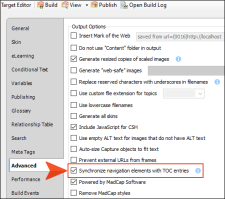Before you start creating
[Menu Proxy — Headings — Online — Depth3 ]
Avoid Duplicate File Names When Importing
You might decide to create a new project from
More Room for First-Level TOC Items
One of the benefits of Side Navigation over Top Navigation output is that the main menu is vertical rather than horizontal. This means you have more space for first-level items in your table of contents (TOC). Whereas most Top Navigation projects keep the number of first-level items in the TOC limited to around six or so, you can have far more first-level items in a TOC designed for Side Navigation.
Therefore, if you are moving from a Top Navigation format to Side Navigation, you might consider rearranging your TOC to include more items at the first level. However, this is not mandatory. If you are happy with a limited number of first-level TOC items, there is no reason to adjust your TOC.
Duplicate TOC Items
If you generate HTML5 output, links to the TOC (e.g., menu items, breadcrumbs, mini-TOCs) are dynamically generated when a particular topic is opened. This lets you keep these navigation elements in sync with your TOC. This is particularly important if the same topic is linked to multiple entries in your TOC; otherwise, menu items and other navigation elements might display for one instance of that topic in the TOC when another instance is preferred.
For HTML5 Tripane output, navigation elements will always remain in sync with your TOC entries. However, for HTML5 Side Navigation, Top Navigation, and skinless outputs, you must enable a feature in your target to synchronize navigation elements with TOC entries.
Synchronizing navigation elements with your TOC entries seems like an obvious decision, and for some authors it is. However, other authors might choose not to do this for their Side Navigation, Top Navigation, or skinless outputs. There are pros and cons.
See Synchronizing Navigation Elements With TOC Entries.
Note If you decide not to use this option for your HTML5 Side Navigation, Top Navigation, or skinless output but you are still concerned about having duplicate TOC links, there is a workaround. You can create a snippet that holds all of the content for the topic. Then create multiple topics (as many topics as you need links to it in the TOC), and insert that snippet into each one. Rather than linking to one topic in multiple places in the TOC, you can link to a different topic in each place. By doing that, your navigation elements will point to the appropriate locations. You probably want to disable searching in all but one of those topics; otherwise, they will all show up in the search results


